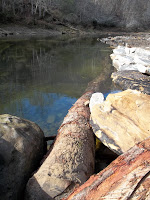Guys I wanted to share some
of the good things that are happening on our tailrace below Smith Lake. There is a mile stretch that Alabama Power is making
improvements on. It will give the area a Western look with all the pebbles and boulders
they are adding. A lot of the water on the stretch has been diverted to create some natural looking seams, deep runs and fast water with less depth. The improvements were drawn up by the Southeastern Engineering Stream Improvement Firm. Trout Unlimited and the Riverside Fly Shop which is located on the tailrace worked closely with the Engineering group. The results have been spectacular as far as this area is concerned for trout fishing. The following images below can give you some insight into the work that has been done. All of the improvements for this area should be finished by the end of January. The work on the next two mile stretch will begin next fall below the pump station. After that completion there will a little over 3 miles of Western style trout fishing here in Jasper. Think of the revenue that can be produce for this cash striped county.

One will have much more room for the back cast now
Notice the large rocks that have been added
There is very little water that is flowing while all this work is going on.
This image was taken after they completed this area, the water was shut down the next day to start work above this area--can't wait to fish this place!!
Some of the smaller rocks that are being place in the stream bed.
Here is another area that is complete, a lot of rock broaders are being used
Finished stream that has been narrow with depth and underwater logs
Huge boulders at the edge of a deep hole with underwater logs--this should be a great area
This area use to be extremely wide and shallow; it is half the that size now
A little creek area flowing into a small pool which opens up at the other end--interesting place to fish for trout































